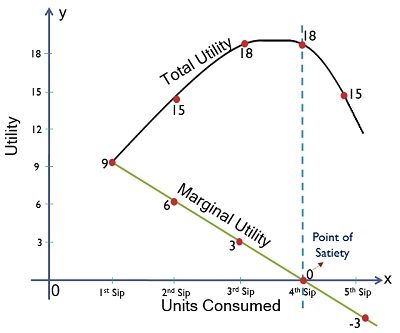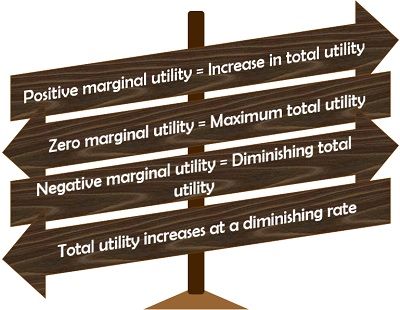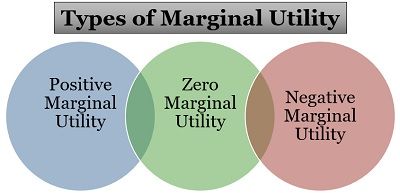Definition: Marginal utility (MU) is the utility acquired from consuming an additional unit of a commodity. Utility refers to the ability of a product to fulfil a person’s need, want or desire, which keeps on diminishing as the following unit of a commodity is consumed.
Formula of MU
Though a utility cannot be measured in exact numbers, it is up to the consumer to represent his satisfaction level in terms of derived utils. Util is assumed as a unit for measuring the satisfaction derived from a commodity. It is also considered as a unit for measuring MU.
Where,
MUx is the marginal utility of commodity x;
ΔTUx is the change in total utility of commodity x;
ΔQx is the change in the quantity of commodity x.
Total Utility: Total utility is the amount of satisfaction which a person derives from consumption of all the units of a commodity at a particular time.
Formula of Total Utility
Where TUx is the total utility of commodity x;
ΣMUx is the sum of all the marginal utilities of commodity x.
Content: Marginal Utility (MU)
Assumptions of Marginal Utility
For making the concept of MU more clear and easy to understand, the following assumptions are taken into consideration:
- Cardinal Utility Concept: It is assumed that the utility of a commodity can be measured in terms of a specific unit, named ‘util’.
- MU of Money is Constant: It is presumed that the MU of money is always constant while a person keeps on spending on a commodity.
- The hypothesis of Independent Utility: It is assumed that the utility derived from each commodity is independent of that derived from the other, overseeing the concept of complementary goods.
Example
Let us now strengthen our concept over marginal utility and total utility with the help of the following illustration:
A person returned home from the market on a bright sunny day. He was extremely thirsty and grabbed a bottle of cold water to satisfy his thirst.
To analyse the marginal utility and total utility which he derives from each sip of water, we must go through the following utility schedule:
Utility Schedule
| Units Consumed (Sip of Water) | Marginal Utility (MU) (in Utils) | Total Utility (TU) TU = ∑MUx (in Utils) |
|---|---|---|
| 1st Sip | 9 | 9 |
| 2nd Sip | 6 | 15 |
| 3rd Sip | 3 | 18 |
| 4th Sip | 0 | 18 |
| 5th Sip | -3 | 15 |
From the above schedule, we can analyse that in the first sip the person achieves the highest level of satisfaction since the MU is at its highest is nine utils. The total utility is also nine at this point.
The MU or satisfaction level goes on decreasing with each sip until the third sip of water. The total utility is increasing but at a diminishing rate.
At the fourth sip, the MU becomes zero, which indicates that the person is not feeling thirsty anymore. The total utility remains constant.
Eventually, at the fifth sip, we can see that the MU becomes negative. This indicates that the person is deriving negative utility out of his consumption and that any additional sip may affect him adversely. At this point, the total utility starts declining.
Graphical Representation of Marginal Utility and Total Utility
The above example is plotted on a graph to view the relation of marginal utility with the total utility:
Relation Between TU and MU
In the above example, we have already seen that the marginal utility and the total utility are the interlinked concepts.
The following points determine their relationship more clearly:
Positive marginal utility = Increase in total utility
If the MU is a positive unit, we may say that the total utility goes on increasing. It means that the consumer is getting positive satisfaction out of each unit consumed.
Zero marginal utility = Maximum total utility
When the MU becomes zero or neutral, the total utility is at its maximum. Thus, stating that the consumer has reached the optimum level of satisfaction. This is the ‘Point of Satiety’.
Negative marginal utility = Diminishing total utility
As the marginal utility shows a negative value, the total utility also begins to drop. It indicates that the consumer no longer needs the commodity for that particular period.
Total utility increases at a diminishing rate due to falling marginal utility
When the marginal utility is decreasing with the consumption of each additional unit but is neither zero nor negative, total utility increase but at a decreasing rate parallel to the rate of marginal utility.
Types of Marginal Utility
MU is generally seen as diminishing with the consumption of each additional unit though at times it can be seen as increasing too. This feature determines its type.
To know more about its different types, please go through the following explanation with examples:
Positive Marginal Utility: A consumer derives a minor satisfaction each time on consuming an extra unit of a commodity.
For example; a hungry person feels the highest satisfaction while eating the first slice of bread. Then the pleasure goes on decreasing with the consumption of more bread slices since he is no more hungry.
Zero Marginal Utility: In zero MU, a consumer becomes neutral towards the consumption of a commodity since it doesn’t satisfy him.
For example; a healthy person gets a pack of insulin injections, which is of no utility to him.
Negative Marginal Utility: A consumer is having an adverse effect or deriving a negative satisfaction from each additional unit.
For example; a person participating in a burger eating challenge feels full after eating four burgers but is still eating those additional ones to win the competition.
MU is not uniformly applicable to all kinds of commodities or activities. For some, it is positive while for others, it is negative. Some products even have a zero marginal utility.
Olien Deen says
Thank u so much . It has helped me not only in doing assignment but also cleared my concept about the topic too.